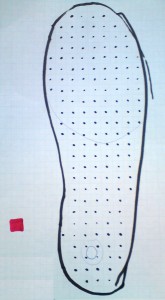Here is your homework for the current topic. Please hand this in to me no later than Friday 27th August.
Late jotters will not be accepted.
with mr mackenzie
Here is your homework for the current topic. Please hand this in to me no later than Friday 27th August.
Late jotters will not be accepted.
The Physics experts at Sixty Symbols have been playing with a vuvuzela. Here is a film showing their experiments on frequency and sound filtering.
We deviated from the script a little this week to look at how choice of shoes can affect the pressure put on the ground beneath your feet. If we know the size of the force (F) and the area over which the force is applied (A), then we can calculate pressure using
So when we start talking about shoes, we need to figure out the surface area of the footwear. Luckily, Caitlin had flat-soled shoes on and volunteered to provide data for our calculation. Here is the outline of her shoe, it’s drawn on graph paper so that the area can be calculated quickly by counting the large squares. Each large square is 1 square centimetre – we counted the approximate area by considering only whole squares inside the black outline of the shoe.

Assuming a mass of 50kg, the pressure when wearing the flat shoes is
The red shaded area of our photo shows the reduction in area when heels are worn. With heeled shoes, the area is reduced to approximately 1 square cm per shoe. The change in the pressure is staggering:
The Science Babe has made a video on this topic. Good physics in here, although I’m not sure she can claim the equation shown above is Newton’s 2nd law. What do you think?
FIFA claim that the cup is
made of solid 18 carat (75%) gold
but Professor Poliakoff from The Periodic Table of Videos has been looking at data for the trophy and, using the density of gold, he reckons it is hollow.
The wikipedia page the professor mentioned is here.
Interestingly, the professor’s calculator looks almost as old as mine.
I had a comment that the Higher solutions on the webtribe site were no longer available. I can’t get in to them either but I do have a copy of the site that I use in school when there are filtering issues.
I have uploaded my version of the site to
http://www.mrmackenzie.org/webtribe/ie.html
I hope the person who created the original site does not mind me mirroring the content. Please get in touch is this is a problem and I will remove it. Obviously I am only interested in making this available until Friday.
Lasers are celebrating their 50th birthday this year. The first laser was demonstrated in 1960 by Theodore Maiman and his research group at Hughes† in California. Here is a good background article on the first laser, its inventor and the role that Einstein played in developing the theory of stimulated emission.
The principle of laser operation is outlined in this description of Maiman’s laser, which used a rod of polished ruby inside a spiral flashtube.
My favourite James Bond film, Goldfinger, has a scene where Sean Connery (the best 007 imho) is strapped to a table under a huge red laser. It should have been a saw but the invention of the laser, just 4 years earlier, was a gift for the writers. This scene helped the film win the best effects Oscar in 1965 and, more importantly, gave us the ultimate Bond quote:
Bond: Do you expect me to talk?
Goldfinger: No, Mr. Bond, I expect you to die.
Everyone should watch the laser scene.
Bonus points if you can tell me about the bad physics in that clip.
†I used to work for Hughes before I trained as a physics teacher – the Glenrothes branch, not Malibu Beach, California.
Here is paper I from 1999.
There is a complete set of answers for this paper here.
This paper is reproduced to support SQA qualifications on a non-commercial basis according to SQA conditions of use.
We looked at the photoelectric effect this week. There is a useful simulation of the photoelectric effect here. You can change the metal under investigation to confirm that different metals have different work function values. You can also vary the wavelength and irradiance of the light.
Notice that below the theshold frequency you can’t get any photoelectrons, even if you set the light to its brightest setting.
Paper I from 1998 is attached.
There is a complete set of answers for this paper here.
This paper is reproduced to support SQA qualifications on a non-commercial basis according to SQA conditions of use.
This amazing footage of the Saturn V rocket launch for the Apollo11 moon landing mission has been put online by Mark Gray. The video provides an extra dimension to the launch photograph in my earlier post about Newton’s 3rd law of motion. While that picture shows an enormous plume of gas being forced out of each rocket exhaust, the video below demonstrates the heat of the gases and the effect they have on the structure of the launch pad itself.
Apollo 11 Saturn V Launch (HD) Camera E-8 from Mark Gray on Vimeo.